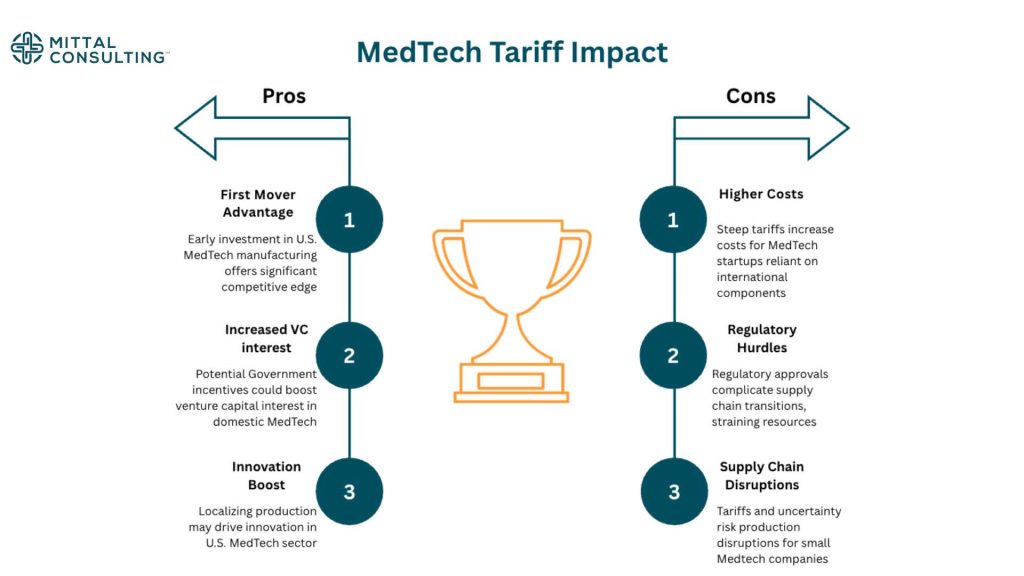Navigating the New Trade Terrain: What U.S. Tariffs Mean for Medtech Investors and Startups
By- Elle Winn (Mittal Consulting)
It is no secret that the new administrations pivot to an aggressive tariff strategy, including a 145% duty on goods from China and 10% baseline tariff for most other countries, has created a higher-stakes environment for the U.S. med-tech space. While for larger established companies, this means some cost pivots and other adaptations, this change in tariff strategy presents both significant headwinds and emerging strategic opportunities for small MedTech companies, startups, and their investors.
Smaller companies and startups, especially those reliant on international supply chains, are the most vulnerable to this economic shift. Many early-stage MedTech companies source important components (including semiconductors, sensors, electromechanical parts, and the like) from countries where labor and manufacturing costs have historically been lower. Now, these components are subject to steep tariffs, eroding margins at the exact stage when startups and small companies need capital efficiency to scale.
This pressure from the rising costs is compounded further by regulatory friction. Changing manufacturing process to avoid tariffs is no simple feat. Supply chain validation and approvals or clearances by the FDA are complex, time-consuming processes that require company time and resources to complete. Even in stable economic conditions, these transitions are challenging; but with added pressure from tariffs and trade uncertainty, they become even harder to manage, putting startups and smaller companies at greater risk of production disruptions and financial strain.
For investors, however, this shakeup may offer a first-mover advantage. The tariffs are now forcing a reconfiguration of global supply chains, which in turn results in the necessity for early investment in U.S.-based MedTech manufacturing. This offers some particularly promising opportunities to support MedTech startups as they transition to domestic assembly. In addition, some analysts suggest that venture capital interest could increase if tariffs are eventually paired with targeted government incentives, such as tax credits or R&D grants. While no such policies have been announced, the potential for industrial support aimed at boosting U.S. MedTech manufacturing could make startups aligned with domestic production more attractive to investors.

To navigate this environment, startups and small companies should prioritize supply chain diversification, exploring partnerships in low-tariff countries, and consider strategic stockpiling of key inputs. Now more than ever, geographic sourcing, tariff exposure, and regulatory agility will all need to be considered during business and product development processes.
What should MedTech startups be doing right now?
- Audit tariff exposure across the supply chain
- Explore sourcing from low-tariff countries
- Build agility into manufacturing and regulatory plans
- Consider stockpiling key inputs to buffer disruption

This moment isn’t just about surviving tariffs — it’s about rethinking strategy. Those who localize early and align with evolving policy and investment trends may emerge not just intact, but as leaders in a new era of U.S. MedTech innovation.
The bottom line is this: the shift in tariff strategy poses more than a cost issue to small MedTech companies and startups; it is a strategic reset. Companies that proactively adapt to this new trade reality by localizing production and de-risking their supply chains may be best positioned to attract capital and lead the next wave of U.S. MedTech innovation.
References:
https://www.knobbe.com/blog/u-s-tariffs-and-the-medical-device-industry
https://www.medtechdive.com/news/Medtech-tariffs-Q1-earnings/745277
